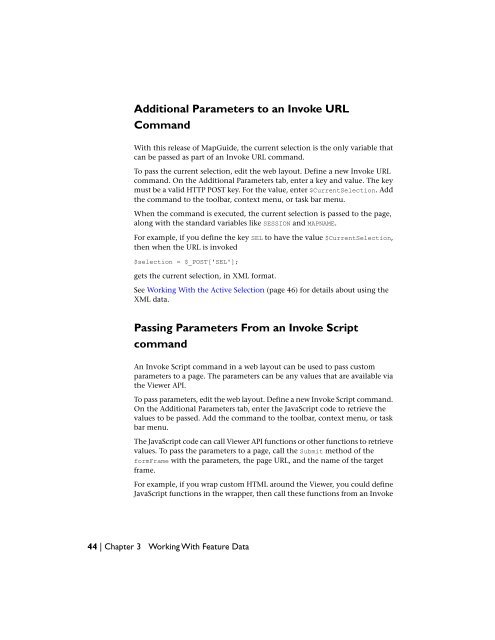Developer's Guide - MapGuide Open Source - OSGeo
Developer's Guide - MapGuide Open Source - OSGeo
Developer's Guide - MapGuide Open Source - OSGeo
Create successful ePaper yourself
Turn your PDF publications into a flip-book with our unique Google optimized e-Paper software.
Additional Parameters to an Invoke URL<br />
Command<br />
With this release of Map<strong>Guide</strong>, the current selection is the only variable that<br />
can be passed as part of an Invoke URL command.<br />
To pass the current selection, edit the web layout. Define a new Invoke URL<br />
command. On the Additional Parameters tab, enter a key and value. The key<br />
must be a valid HTTP POST key. For the value, enter $CurrentSelection. Add<br />
the command to the toolbar, context menu, or task bar menu.<br />
When the command is executed, the current selection is passed to the page,<br />
along with the standard variables like SESSION and MAPNAME.<br />
For example, if you define the key SEL to have the value $CurrentSelection,<br />
then when the URL is invoked<br />
$selection = $_POST['SEL'];<br />
gets the current selection, in XML format.<br />
See Working With the Active Selection (page 46) for details about using the<br />
XML data.<br />
Passing Parameters From an Invoke Script<br />
command<br />
An Invoke Script command in a web layout can be used to pass custom<br />
parameters to a page. The parameters can be any values that are available via<br />
the Viewer API.<br />
To pass parameters, edit the web layout. Define a new Invoke Script command.<br />
On the Additional Parameters tab, enter the JavaScript code to retrieve the<br />
values to be passed. Add the command to the toolbar, context menu, or task<br />
bar menu.<br />
The JavaScript code can call Viewer API functions or other functions to retrieve<br />
values. To pass the parameters to a page, call the Submit method of the<br />
formFrame with the parameters, the page URL, and the name of the target<br />
frame.<br />
For example, if you wrap custom HTML around the Viewer, you could define<br />
JavaScript functions in the wrapper, then call these functions from an Invoke<br />
44 | Chapter 3 Working With Feature Data


